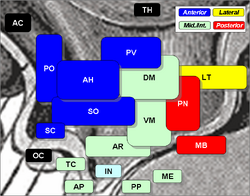No edit summary |
No edit summary |
||
| Line 25: | Line 25: | ||
The '''lateral hypothalamus''' or '''lateral hypothalamic area''' is a part of the [[hypothalamus]]. |
The '''lateral hypothalamus''' or '''lateral hypothalamic area''' is a part of the [[hypothalamus]]. |
||
| − | It includes the [[ |
+ | It includes the [[lateral hypothalamic feeding centre]] which is important in regulating [[appetite]] and [[hunger]]. Damage to this area can cause reduced food intake and [[lateral hypothalamic syndrome]]. Stimulating the lateral hypothalamus causes a desire to eat, while stimulating the [[ventromedial hypothalamus]] causes a desire to stop eating. |
== Function == |
== Function == |
||
Latest revision as of 09:32, 13 June 2013
Assessment |
Biopsychology |
Comparative |
Cognitive |
Developmental |
Language |
Individual differences |
Personality |
Philosophy |
Social |
Methods |
Statistics |
Clinical |
Educational |
Industrial |
Professional items |
World psychology |
Biological: Behavioural genetics · Evolutionary psychology · Neuroanatomy · Neurochemistry · Neuroendocrinology · Neuroscience · Psychoneuroimmunology · Physiological Psychology · Psychopharmacology (Index, Outline)
| Brain: Lateral hypothalamus | ||
|---|---|---|
| Lateral hypothalamus is 'LT', at right, in yellow. | ||
| [[Image:|250px|center|]] | ||
| Latin | ' | |
| Gray's | subject # | |
| Part of | ||
| Components | ||
| Artery | ||
| Vein | ||
| BrainInfo/UW | hier-409 | |
| MeSH | A08.186.211.730.385.357.300 | |
The lateral hypothalamus or lateral hypothalamic area is a part of the hypothalamus.
It includes the lateral hypothalamic feeding centre which is important in regulating appetite and hunger. Damage to this area can cause reduced food intake and lateral hypothalamic syndrome. Stimulating the lateral hypothalamus causes a desire to eat, while stimulating the ventromedial hypothalamus causes a desire to stop eating.
Function
The glucostatic explanation is based on the homeostatic theory which indicates that the body has balanced states of equilibrium for each system. When out of balance, the body will be pushed to restore balance. Therefore, when the blood sugar level drops, the glucostatic receptors in the blood take a message to the lateral hypothalamus, which is the feeding center of the brain. This causes certain neurons in the brain to fire in unison, creating the sensation of hunger. Now the person wants to eat.
When the glucose level increases because the person is eating or has eaten, the glucostatic receptors in the blood then send a message to the Ventro-medial Hypothalamus (the satiety or satisfaction center) and the sensation of fullness occurs.
Damage to the lateral hypothalamus may lead to a condition known as Frölich's syndrome.
Lateral zone of hypothalamus
The "lateral zone of hypothalamus" is a similarly named compound structure, consisting of the following two structures:[1]
- lateral hypothalamic area
- lateral preoptic nucleus
References
Template:Neuroanatomy-stub
| This page uses Creative Commons Licensed content from Wikipedia (view authors). |
